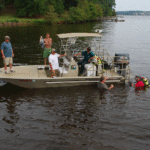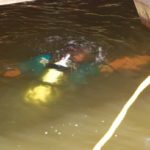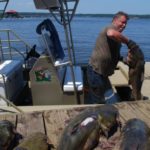
This sport might be just a little bit crazy, but these guys have a ‘hole’ lotta fun doing it.
It was late evening in the early summer. The five men assembled on the back deck of the Petrus family camp, set on a hill slope overlooking Lake D’Arbonne, were engaged in a masculine redneck ritual. Bobby Petrus, a.k.a. “The Claw,” was grilling meat, and all of them were exchanging humorous insults.
The rough-and-tumble humor, mixed with an equal blend of braggadocio and self-deprecation, was delivered with powerful North Louisiana twangs in what a Cajun or a New Orleanian would consider a foreign language.
Kyle Lowery, 28, Stephen Mann, 48, and Petrus, 51, were part of a catfish “wrastl’in” crew headed up by the legendary “Catfish Jack.” The 62-year old, known in West Monroe business circles as Jack Clampitt, had not yet arrived.
I had traveled to Arkansas’ doorstep to fish with Catfish Jack and The Claw.
Also on hand was neighbor Buck Carlisle, who could verbally hold his own with the first three, and Alton Smith, a visitor from Dallas. Whether he was outgunned, shy or simply felt the newcomer, Smith was discreetly quiet during the riposte. Carlisle wasn’t planning to join the men on the water the next day.
“I don’t get in the water,” he explained. “If I go, I operate the ice chest — yup, I’m the ice-chest operator.”
Out of the corner of my eye, I caught a glimpse of a canary-yellow Hummer as it pulled up behind the camp. Before the vehicle door slammed, I heard the man’s roar.
“That would be Jack,” one of the men explained with a twinkle in his eye.
Around the corner of the building rumbled a bear of a man, 6-foot-1 and 330 pounds. And he was still bellowing. He boldly strode up and took control of the deck, both with his bigger-than-life persona and his booming voice. Although introductions had already been made, he made new ones spiced with insults.
Mann and Lowery received special attention, although Petrus received glancing blows. Carlisle caught an occasional ricochet, but mostly he served as Clampitt’s audience. The first two did the best they could to counterpunch, but it was like trying to push water up a waterfall. Clampitt just lathered on more abuse.
Smith was absolutely quiet and had backed to one corner of the deck. He looked like a man secretly glad that Clampitt didn’t know him. The good spirit of Clampitt’s attention showed up as grins on the other men’s faces, however.
While the other men refreshed their beverages, Clampitt provided a short lesson for me. What they would do tomorrow, called “noodling” in many places, is dive into the lake’s waters and with their hands, grab large flathead catfish by their jaws and haul them out of their spawning cavities and to the surface.
Clampitt began the practice, which to most fishermen seems bordering on insane, 25 years before.
“I learned it from an old boy out of Mississippi named Tommy Cleveland,” he said. “He taught me how to build the tanks. Then me and Bobby started fishing together 18 years ago. We formed a rules committee for our group.”
“Yeah,” interjected Lowery, “They make the rules, and me and Stephen do all the work.”
As a deep twilight settled over the camp deck, the bantering and tale-telling became industrial strength — irreverent, no holds barred. Then Petrus announced that the steaks were ready, and the men retreated inside. Each man fixed his plate and then, incongruously, as a group they bowed their heads in prayer. The benediction, lead by Petrus, ended with the words, “and Lord have mercy on them Opelousas cats tomorrow.”
Before the men retired to their bedrooms, Petrus’ right hand reflexively cocked back like a mechanical claw and he looked at Clampitt with a glint in his eye.
“I ain’t been in a while. I’m ready to rip one’s jaw off,” he said. “I’m worried I might rough ‘em up too much tomorrow.”
I could still see the claw-like hand as I drifted off into a deep sleep.
The next morning, I joined the men in the kitchen at 7 a.m.
“That’s the good thing about this,” Clampitt greeted me. “You don’t need to get up early. And the weather doesn’t affect the fishing; none of that barometric-pressure stuff.”
Present as expected for the raid besides Clampitt were Petrus, Mann and Smith. Carlisle unexpectedly joined the group with his son, Kevin. Absent was Lowery, who had a prior obligation.
Clampitt was in an expansive mood as the others prepared a big country breakfast of biscuits, scrambled eggs and sausage, so I began plying him with questions over coffee. First I asked what they call their quarry, which is notorious for its names and nicknames, including but not limited to Opelousas cats, Ops, tabbies, flathead catfish and yellow catfish.
He made quick work of that one.
“We call them Ops, but mostly we call them food,” he said. “Yeah, we do catch and release — into the grease.
“My goal is to put up 52 gallon bags just for me. The more you eat, the more you want.”
I asked about the cavities the men pull the fish from, envisioning them being hollow logs and submerged caves under the lake’s banks. Instead they are man-made, almost always in their case constructed around a steel bathtub. They have tried other kinds of “tanks” as they call them, including aluminum fuel tanks from 18-wheelers and halved ABS plastic culverts, but none seems to work as well as the bathtubs.
Once a tank is in place on the bottom, the site is called a “set.” Sets are made in water 4 to 10 feet deep, with an average depth of 6 feet. The men have 30 sets now, considered the bare minimum number, and they have had as many as 70. A larger number of tanks allows each member of the crew to run several. Some of their tanks have been in action as long as 15 years.
Sets are usually “run” once a week during the Op spawning season in Lake D’Arbonne, which lasts from the first of May to July 4, although an occasional fish can be caught later in July. Curiously, the season in Lake Bistineau, a favored location in the past, begins and ends two weeks earlier than it does in Lake D’Arbonne.
They have also in the past placed sets in Lake Claiborne and Toledo Bend Reservoir as well as Lake Bistineau. The latter lake became choked with the invasive water weed salvinia, “ruining” it in Clampitt’s words. They abandoned it two years ago. Clampitt doesn’t fret, however. He maintains that no place has as many big fish as D’Arbonne does.
The fish that they keep range from 15 to 70 pounds, according to Clampitt.
“If we catch one under 15 pounds, after he’s properly laughed at, we turn him loose,” he said.
After stowing away the ample breakfast, the six men sauntered down the hill to board Clampitt’s custom-built 22-foot aluminum dive boat. The motor barely warmed up before the first stop. The tank was under a nearby camp wharf.
With a wave of his imaginary scepter, Clampitt decreed that his old diving pal, “The Claw” Petrus, would be the first diver. Before he stepped overboard, Petrus took a “piggin’ stick” in hand. This was simply an 8-foot length of ½-inch conduit pipe with an eye-bolt on one end to which was snapped a 20-foot length of poly rope tied to a dog dummy — the kind used to train retrievers.
The other end of the stick, the business end, is a welter of bolts and nuts, which serves to “rile ‘em up and run ‘em out,” into the diver’s hands. As Petrus half waded/half swam to the tank, Smith gradually paid out the poly line to keep him from getting tangled in it. Mann entered the water with him, ostensibly to provide help if needed, but he seemed to really enjoy just being in the soothing waters of the lake.
While he was down, Clampitt helpfully described what was hopefully going on underwater. Once the diver locates the tank, he inserts both legs up to his waist in the throat to block exit from the tank. Then he inserts the knobby end of the pigging stick beside his body into the tank. He pokes and probes, seeking to make the fish try to run out of the throat of the tank.
“The fish will come out at 30 miles an hour and hit you in the crotch,” he said. “They will try to get their head under your butt and will actually pick you up.
“If the diver lets him get under his leg or seat, he is gone.”
That’s the ultimate disgrace for a noodler.
From the chest-deep water, Mann added that gripping the top of the throat with one hand and using it to push one’s seat and legs down flat on the bottom is helpful.
If all goes well, Clampitt explained, the diver will grab the fish by its lower jaw with both hands, and then pin the fish to the top of the throat with his knees. Then he lets go with one hand and unsnaps the poly rope from the pole. He either runs the end of the rope through the mouth of the fish and out the gill cover or through the gill cover and out the mouth.
He pulls the line through the fish’s mouth to within 3 or 4 feet of the dummy float, then granny knots the line. This keeps the fish from tangling up the diver while he is stringing up the second fish — if there is one. After the fish are strung, the line is snapped back to the end of the piggin stick, and the diver returns to the boat with his catch.
Petrus surfaced and reported “nothing,” before climbing up the stern ramp. Next stop produced what Petrus dismissively described as a 5-pound “bullhead,” as spawning male channel catfish are often called because of their distortedly swollen heads.
At the third stop the report was “nobody home,” opening the floodgates of teasing for Petrus.
“Check his britches to see if they’re slimy,” ordered Clampett. (A fish that gets away under the diver leaves a coating of slime on his pants.) Petrus stood there dripping water and took it with a grin.
“This is the lying-est sport you ever seen,” Clampitt goes on for my benefit.
Mann then gave up another reason for someone on the boat to hold the end of the rope snapped on the piggin stick.
“It keeps the lying down,” he said. “If the piggin stick hits a fish, the guy with the rope can feel the jiggle. The diver can’t lie.”
Finally on the fourth set, Petrus hit the jackpot. He surfaced with two big catfish, one about 40 pounds and the other estimated at 35 pounds. After he handed the fish to the men in the boat for stowing in the huge livewell, he cocked his claw hand for everyone’s benefit and grinned mischievously.
Clampitt decreed that it would now be Mann’s turn to dive until he got a couple of fish and turned the boat north to head from the spillway area of the reservoir up into Corney Creek Arm.
“See what they do to me,” whined Mann unconvincingly. “I’m gonna run a bunch of gar holes.”
Clampitt grunted out a reply while suppressing a grin. “They’re not totally gar holes. They’ve caught. Probably not in this century, but … .”
This wasn’t a wilderness experience. The lake, especially the lower part of the lake, was surrounded by beautiful year-round residences and swanky camps set on manicured lawns and surrounded by lush gardens. Much of the diving they did was in those people’s immediate front yards. It felt odd.
As the boat worked its way north, the structures became more modest and more closely resembled functional fishing camps. Snags of drowned trees stippled the water’s surface, and more laid just below. Travel anywhere out of marked boat lanes was at idle speed only.
Clampitt wasn’t through capping on Petrus.
“The first TV show we did [They have done seven episodes on the national Outdoor Channel and have been on four local television channels] we talked about Bobby getting a new wife,” he said. “He had just gotten divorced. We said that he had a lotta money, good teeth and all that. Dang, if we didn’t get him one.”
Then Clampitt, with Mann’s connivance, harangued Petrus about his wife being in charge. I must have looked unimpressed because Mann dialed Petrus’ wife’s phone number and handed the cell phone to me. Sure enough, a feminine voice on the voice mail introduced herself as “The Claw’s Boss.” I couldn’t tell who was having more fun, Clampitt and Mann dishing it out or Petrus getting the attention.
As Mann predicted, the tanks on this end of the lake held fewer fish and only one was large enough to keep. In the forest of stumps they were also harder to find. The air was punctuated by an abundance of “yonders, over yonders, right chonders” and “yonder a pieces,” as the men exchanged opinions about the locations of the sets.
Anticipation built up as they approached the Cindy Crawford set, always a good one. The set was named after a lady that is often seen on the pier.
“She looks like Cindy Crawford,” explained Mann, “only 200 pounds heavier.”
Clampitt laughed evilly in response to Mann’s explanation.
“If you can’t have a little fun in life, what’s the sense in living — and we have fun,” he said.
Each set had a name: Chrysler key (It has a car key nailed to a piling next to it.), cypress dock, ghost pier, black bikini, Bear Creek, walk off, satellite and light switch (which has a light switch cover nailed to a tree) were a few of them.
“He’s been under a long time,” observed one of the men about Mann’s dive. “Yeah, he’s got two fish,” responded Petrus.
As if on cue, Mann’s head popped out of the water, and two big mottled, olive drab bodies rolled to the surface with him. He spit out his mouthpiece and yelled “yahooo!”
The rest of the trip had Petrus, Mann and even Clampitt alternating dives. Smith and the younger Carlisle worked as deck helpers and, true to his promise, Buck Carlisle was a master ice-chest operator.
The final tally was six big keepers and a belly full of laughs.
Yes, they do have fun on D’Arbonne, even if they stick their hands down fish mouths.







